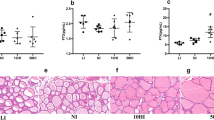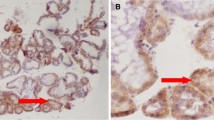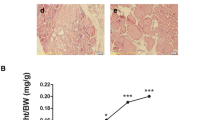Abstract
The sodium/iodide symporter (SLC5A5, also known as NIS) is a transmembrane glycoprotein. Physiologically, iodide transportation in the mammary gland occurs during late pregnancy and lactation. To identify factors that may regulate this process at different iodine levels, we have studied the expression of NIS gene and protein in cultured mammary gland explants from lactating mice by real-time quantitative PCR and In-Cell Western methods. Mammary gland cells were grown in media with different levels of iodine for 24 h. The iodine treatment groups consist of low iodine group I (LI-I, 0 μg/l), low iodine group II (LI-II, 5 μg/l), control group (C, 50 μg/l), high iodine group I (HI-I, 3,000 μg/l), and high iodine group II (HI-II, 10,000 μg/l). The cells were then incubated with or without insulin-like growth factor I (IGF-I) or transforming growth factor β1 (TGF-β1) for another 24 h. We found that iodine inhibited NIS mRNA and protein expression in a dose-dependent manner. IGF-I and TGF-β1 further decreased NIS mRNA and protein expression that iodine inhibited at different iodine levels. In summary, we have shown that iodine downregulated NIS expression in cultured mammary gland explants from the lactating mouse. IGF-I and TGF-β1 inhibited NIS mRNA and protein expression in the mammary gland under different iodine levels.





Similar content being viewed by others
References
Spitzweg C, Joba W, Heufelder AE (1998) Analysis of human sodium iodide symporter gene expression in extrathyroidal tissues and cloning of its complementary deoxyribonucleic acids from salivary gland, mammary gland, and gastric mucosa. J Clin Endocrinol Metab 83:1746–1751
Tazebay UH, Wapnir IL, Levy O et al (2000) The mammary gland iodide transporter is expressed during lactation and in breast cancer. Nature Med 6:871–878
Thorpe SM (1976) Increased uptake of iodide by hormone responsive compared to hormone independent mammary tumors in GR mice. Int J Cancer 18:345–350
Rillema JA, Wiliams CH, Moulden J, Golden KL (2001) Effect of insulin on iodide uptake in mouse mammary gland explants. Soc Exp Biol Med 227:32–35
He-shuang D, Yuan-yuan Y, Li-gang W et al (2009) Effect of transforming growth factor-β1- on apoptosis and HSP70 expression of mammary tissue of dairy cow. J Nanjing Agric Univ 32:118–123
Welcsh PL, Mankoff DA (2000) Taking up iodide in breast tissue. Nature 406:688–689
Kogai T, Taki K, Brent GA (2006) Enhancement of sodium/iodide symporter expression in the thyroid and breast cancer. Endocrinol-Relat Cancer 13:797–826
Dai G, Levy O, Carrasco N (1996) Cloning and characterization of the thyroid iodide transporter. Nature 379:458–460
Perron B, Rodriguez AM, Leblanc G, Pourcher T (2001) Cloning of the mouse sodium iodide symporter and its expression in the mammary gland and other tissues. Endocrinology 170:185–196
Yue J, Chao L, Wei T et al (2004) Effect of cytokine on the expression of sodium iodide symporter gene in breast cancer cell. J Nanjing Med Univ 18:3
Cohick WS (1999) Role of the insulin-like growth factor I is essential for terminal end bud formation and ductal morphogenesis during mammary development. Endocrinology 140:5075–5081
Fleming JM, Leibowitz BJ, Kerr DE, Cohick WS (2005) IGF-I differentially regulates IGF-binding protein expression in primary mammary fibroblasts and epithelial cells. Soc Endocrinol 186:165–178
Garcia B, Santisteban P (2009) PI3K is involved in the IGF-I inhibition of TSH-induced sodium/iodide symporter gene expression. Mol Endocrinol 16:342–352
Pekary AE, Hersham JM (1997) Tumor necrosis factor, ceramide, transforming growth factor-β1, and aging reduce Na+/I- symporter messenger ribonucleic acid levels in FRTL-5 cells. Endocrinology 139:703–712
Acknowledgments
This work was funded by a grant from the National Natural Science Foundation of China (30972560).
Author information
Authors and Affiliations
Corresponding author
Rights and permissions
About this article
Cite this article
Yu, X., Shen, H., Liu, L. et al. Changes of Sodium Iodide Symporter Regulated by IGF-I and TGF-β1 in Mammary Gland Cells from Lactating Mice at Different Iodine Levels. Biol Trace Elem Res 146, 73–78 (2012). https://doi.org/10.1007/s12011-011-9227-2
Received:
Accepted:
Published:
Issue Date:
DOI: https://doi.org/10.1007/s12011-011-9227-2




